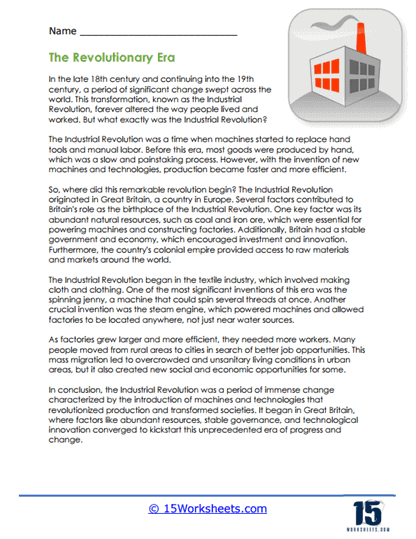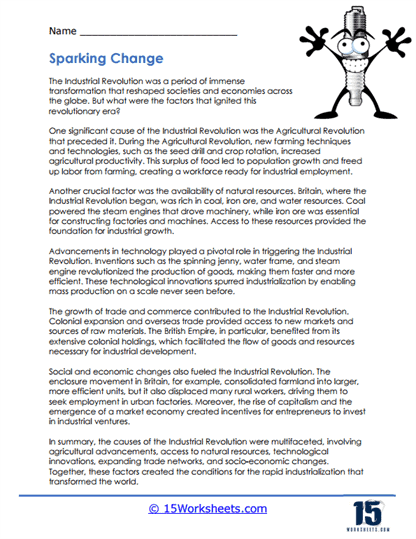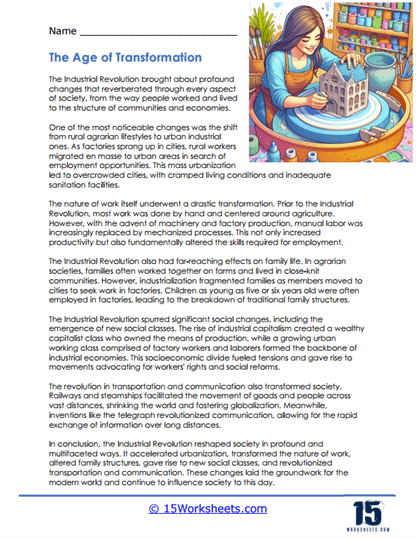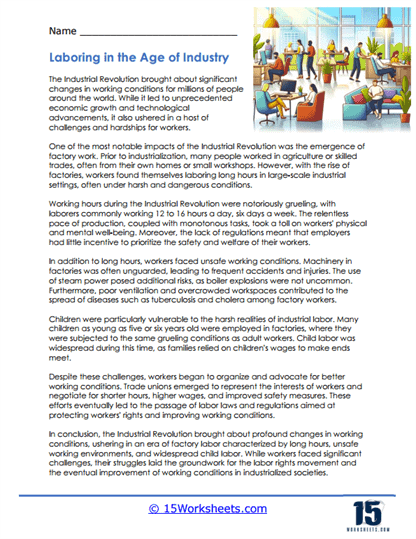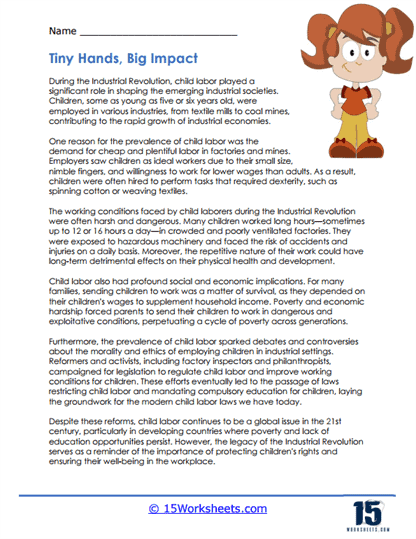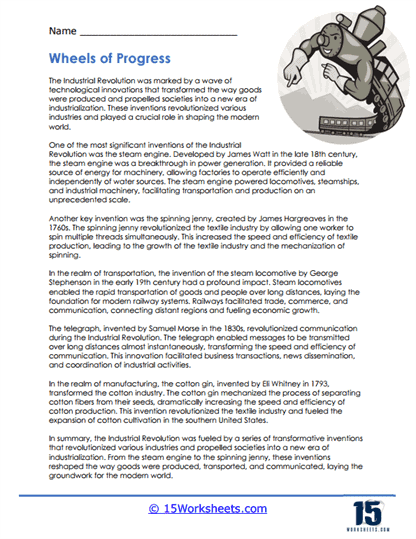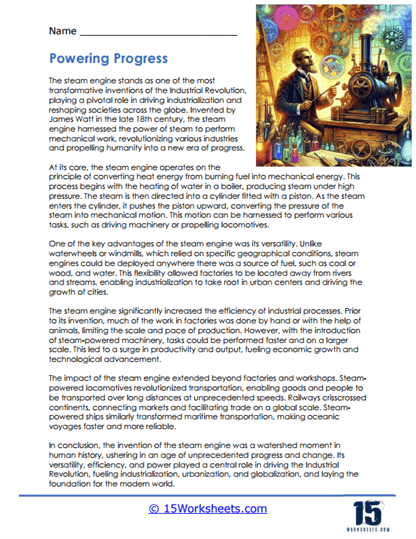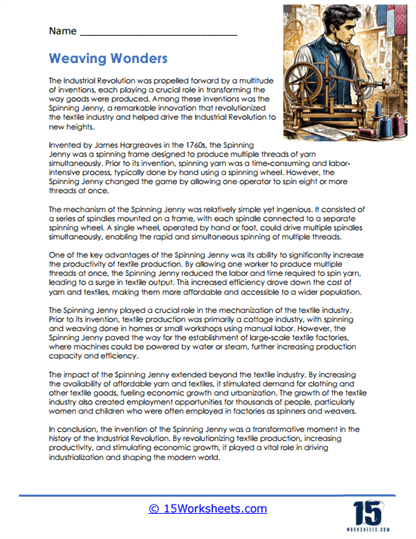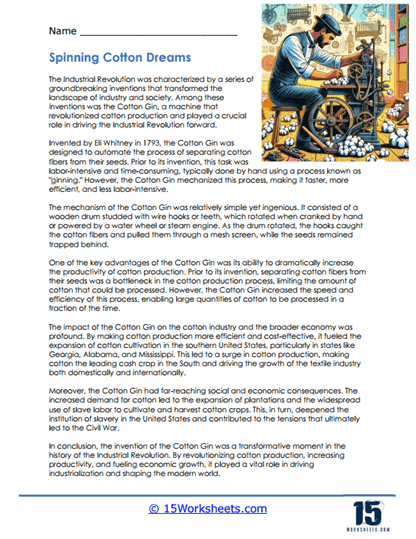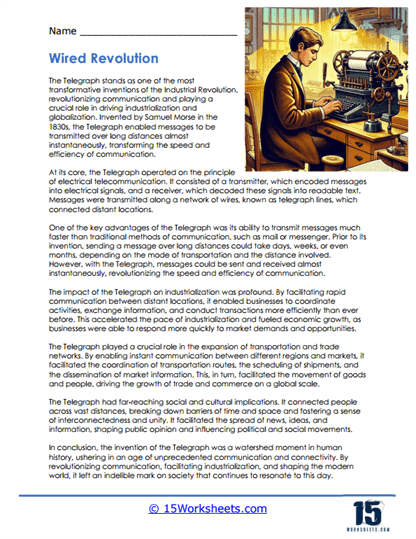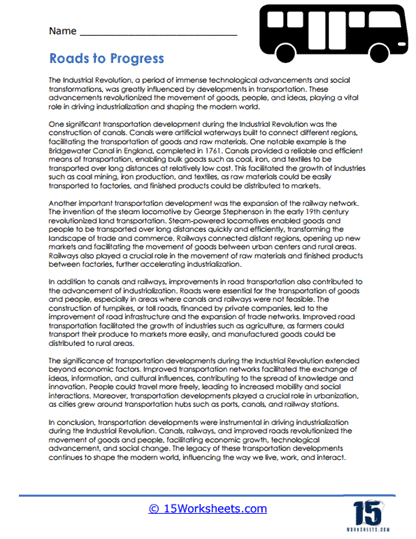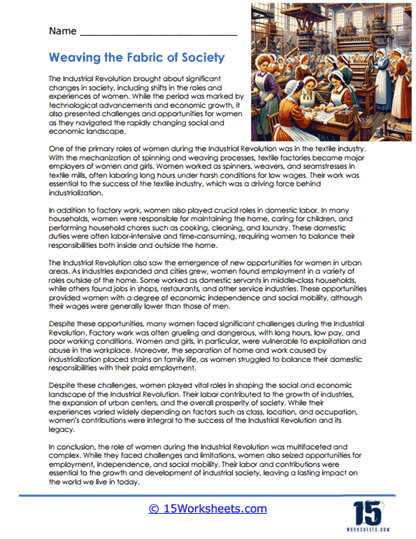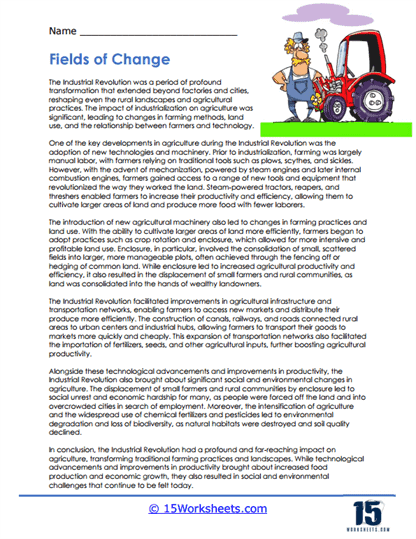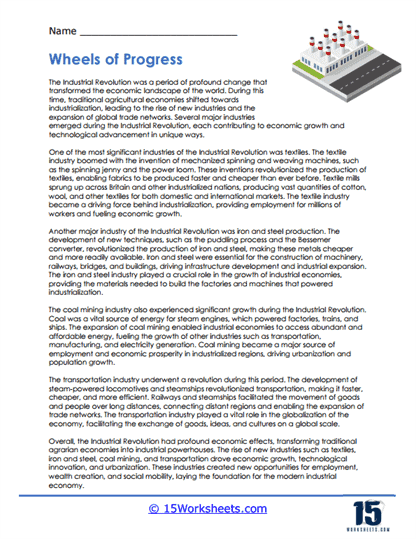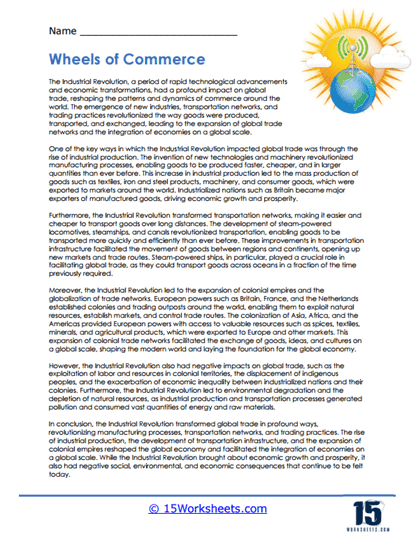Industrial Revolution Worksheets
About These 15 Worksheets
Industrial Revolution worksheets are educational resources designed to deepen students’ understanding of the Industrial Revolution, a pivotal period that began in the late 18th century and continued into the 19th century. This era marked a significant transformation in many parts of the world, particularly in Europe and America, as societies moved from predominantly agrarian economies to industrialized ones. These worksheets encompass a variety of exercises aimed at exploring the technological innovations, social changes, economic impacts, and environmental effects associated with this transformative period.
Through a combination of factual learning and skill development, these worksheets equip students with the knowledge and abilities to critically engage with historical topics and better understand the forces that have shaped our modern world.
Types of Exercises
Reading Comprehension Questions – These questions accompany texts that describe key aspects of the Industrial Revolution, such as the development of the steam engine, the rise of factories, or the migration of rural populations to cities. Students read these passages and answer questions to test their understanding of the content, which helps reinforce key information and concepts.
Multiple-Choice Questions – Multiple-choice questions assess students’ knowledge of specific details, such as dates, inventors, inventions, and the sequence of historical events. These are useful for reviewing and ensuring retention of factual information.
Fill-in-the-Blanks – These exercises require students to insert correct terms or phrases into a provided paragraph, helping them learn and remember key vocabulary and concepts related to the Industrial Revolution. In these exercises, students match terms with their definitions or inventors with their inventions. This type of activity helps solidify students’ understanding of who did what during the Industrial Revolution and the significance of various innovations.
Timeline Activities – Students create timelines to track major events during the Industrial Revolution, such as the introduction of key inventions or legislative reforms. Timelines help students visualize the chronology of events and the progression of technological and social changes.
Essay Writing Prompts – Essays allow students to explore topics in depth, such as the impact of the Industrial Revolution on a particular social class, the comparison between pre-industrial and industrial societies, or the long-term effects of industrialization on the environment. Writing essays develops critical thinking and writing skills, encouraging students to analyze and synthesize information.
Discussion Questions – These questions encourage classroom discussions and help students articulate their thoughts on various aspects of the Industrial Revolution. Discussing with peers can enhance understanding through the exchange of ideas and viewpoints.
How Do These Worksheets Help Students?
Enhanced Knowledge Retention – Regular engagement with diverse worksheet exercises helps reinforce learning and retention of the complex events and concepts related to the Industrial Revolution. Repetition through different formats (e.g., multiple-choice, fill-in-the-blanks) aids in memorizing important details.
Skill Development – Worksheets foster a range of skills, including critical thinking, reading comprehension, analytical writing, and the ability to engage in thoughtful discussion. These skills are valuable not only in history classes but across academic disciplines. Varied activities cater to different learning styles and keep students engaged.
This variety ensures that students not only learn facts but also connect with the material in a meaningful way, enhancing their overall interest and enthusiasm for the subject. The skills developed through completing these worksheets prepare students for the types of assignments and thinking required in higher education. Mastery of these foundational skills can greatly benefit students in future academic pursuits.
Understanding of Cause and Effect – Exercises that require linking causes with effects, such as essay writing and timeline activities, help students understand the causal relationships between historical events and developments. This understanding is crucial for grasping the complex dynamics of the Industrial Revolution.
Empathy and Perspective-Taking – Role-playing and primary source analysis allow students to see the Industrial Revolution through the eyes of those who lived through it, providing insights into the human aspect of historical events.
What Was The Industrial Revolution?
The Industrial Revolution was a profound transformation in the way goods were produced and economies were structured, originating in Britain in the late 18th century before spreading to Europe and North America. This period marked a significant shift from agrarian economies dominated by manual labor and artisanal craft work to industrial economies characterized by machine-based manufacturing, factory systems, and urbanization. The revolution fundamentally changed not just the economy but also the social, cultural, and environmental landscapes of the societies it affected.
Factors That Allowed It to Take Place
Technological Innovations – The period was marked by major advancements in technology that significantly increased the efficiency of production. Key inventions included the spinning jenny, the water frame, and the spinning mule in textile manufacturing, which transformed the fabric industry from a home-based handicraft system to a mechanized, factory-based one. James Watt’s improvements to the steam engine in 1769 also played a crucial role, enabling more effective ways to power machinery, leading to its widespread use in various industries, including mining, transport, and manufacturing.
Availability of Resources – Britain’s rich deposits of coal and iron ore were critical to the Industrial Revolution. Coal was essential for fueling the steam engines and for smelting iron, which was in turn used to build machines and infrastructure such as railways and bridges.
Agricultural Improvements – Prior to the Industrial Revolution, significant changes in agricultural practices, known as the Agricultural Revolution, increased food production and efficiency. These improvements freed up labor by reducing the number of farmworkers needed, which meant that many people moved to urban centers in search of work in new factories.
Economic Conditions and Capital – The trade generated by the British Empire created wealth that funded industrial ventures. Britain’s political stability and its growing overseas empire also provided access to vast markets for its manufactured goods.
Political and Legal Environment – Britain’s political and legal systems supported private property and entrepreneurship. Innovations were encouraged through patents, and a growing banking system provided loans to finance new machines and factories.
Transport Infrastructure – Improvements in transport, particularly the development of the railway network, facilitated the cheap and rapid movement of goods and people across the country, further enhancing industrial growth.
The Results of the Industrial Revolution
Economic Transformation – The shift to machine production led to massive increases in production capacity and efficiency, drastically lowering the cost of goods and making them more accessible to the masses.
Urbanization – As factories sprang up, they tended to cluster in cities located near energy sources and transportation networks, leading to rapid urbanization. This shift was characterized by significant population growth in urban areas, with people moving from rural areas to cities in search of work.
Social Changes – The Industrial Revolution brought about profound social changes. There was a rise of new social classes, including the industrial middle class (bourgeoisie) and the working class. Working conditions in early factories were often harsh, and labor was poorly paid and unregulated, leading to social unrest and the eventual rise of labor movements advocating for workers’ rights.
Environmental Impact – Industrialization had a significant environmental impact, including deforestation, pollution, and the large-scale use of fossil fuels, leading to lasting changes in the global environment.
Global Inequalities – The Industrial Revolution contributed to increasing economic disparities between industrialized nations and those that remained primarily agricultural. It also intensified the processes of imperialism as industrial powers sought new markets and resources worldwide.
Technological and Cultural Impact – The revolution spurred continued innovation in technology and business practices, influencing virtually every aspect of modern society. It also led to changes in cultural practices and norms, including education reforms and new political ideologies.

